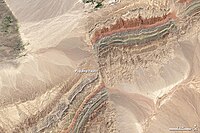
Photo from wikipedia
Most deep saline aquifers consist of multiple layers, and CO2 is generally injected through the injection well in a commingled form with one tubing string. Layer thicknesses and physical properties… Click to show full abstract
Most deep saline aquifers consist of multiple layers, and CO2 is generally injected through the injection well in a commingled form with one tubing string. Layer thicknesses and physical properties such as permeability and porosity vary from layer to layer because of differences in lithology and mineral compositions. When a heterogeneity such as a fault exists, if CO2 is rapidly introduced first into a certain layer, this CO2 reaches fault faster than other layers. Therefore, it is necessary to consider the characteristics of each layer in multi-layered aquifer, particularly in commingled well. In this study, rate allocation by layer was calculated in the multi-layered Pohang Basin aquifer, Korea, and whether CO2 reaches the fault and the pore pressure at the fault exceeds the fault reactivation pressure were investigated to evaluate the stability of the aquifer. In addition, the maximum CO2 storage capacity of the aquifer was estimated and we observed changes in trapping mechanisms over a 1,000-year period after the cessation of injection. The results of the analysis indicate that when up to 50 ktonnes of CO2 was injected into the Pohang Basin multi-layered aquifer over a two-year period, the rate allocations of the upper and lower layers were 70% and 30%, respectively. CO2 did not reach to the closest EF1 fault, and the pore pressure at this fault did not exceed the fault reopening pressure. The maximum possible storage capacity was conservatively calculated under the conditions of fault reactivation pressure (11.7 MPa) and maximum compressor capacity (14 MPa), indicating that a total of 160 ktonnes can be stably injected over six years without reaching the fault. In order to evaluate the stability of the aquifer, the changes in trapping mechanisms over a 1,000-year period were observed. According to the results, structural trapping decreased drastically, from 64.7% to 4.5%, over 1000 years. Meanwhile, solubility and residual trapping increased significantly, from 35.3% to 95.5%. Therefore, the data analyzed to date indicate that the project injecting CO2 in a commingled form from single tubing in the multi-layered Pohang Basin aquifer, Korea, has no possibility of CO2 leakage due to fault reopening.
Journal Title: Geosciences Journal
Year Published: 2019
Link to full text (if available)
Share on Social Media: Sign Up to like & get
recommendations!